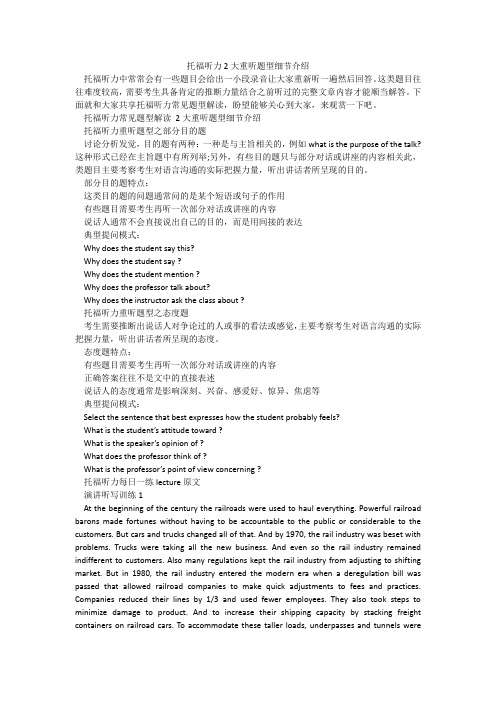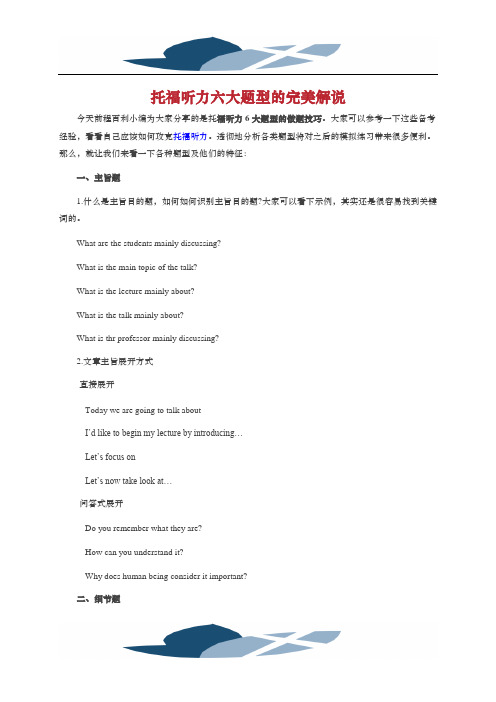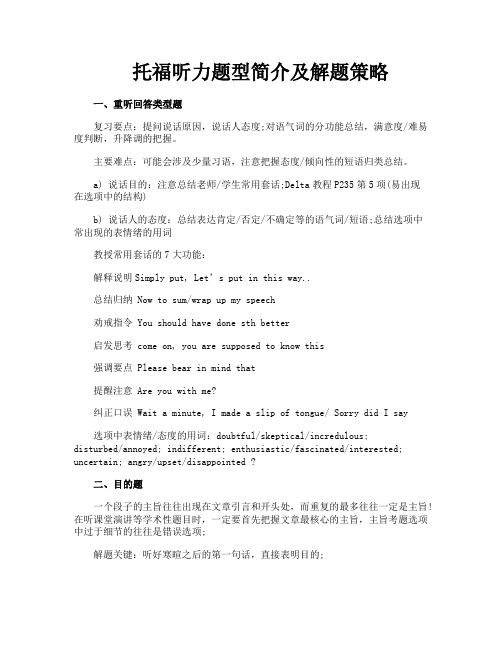托福听力功能题及态度题汇总
托福听力题型分析之态度题

托福听力题型分析之态度题在之前的文章中分析了托福听力考试中的主旨题,细节题,重听题和推断题。
托福考试中,还有很多其他的题目类型,尽管题型和问法皆不相同,但考点和信号词却相近。
因此,在本文中,将继续介绍一种常见题型:态度题。
托福听力题型分析之态度题一、判断题型:在托福考试中,态度题是非常常见的一种题目。
它主要考查的是考生对于文中说话人的态度,感受,观点,好恶等等的理解。
因此,下文中,首先总结了态度题的常见问法,考生考试时先根据问法判断好题型,再依据后面总结的考点和信号词,寻找正确的答案。
常见问法如下:What is the professor’s attitude toward X?What is the professor’s opinion of X?What can be inferred about the student?What can be inferred about the student when she says this?What does the woman mean when she says this?考生们由以上可以看出,当问句中带有attitude, opinion, infer, mean等词时,基本就可以判断题目为态度题,当然,要根据具体情况具体分析。
二.考点和信号词梳理:判断好题型之后,考生们就可以对应笔记位置寻找答案和解题了。
因此,在之前听听力文章的时候,我们就要知道到底文中那些内容需要记录。
那么接下来,从几个方面总结了态度题的常见考点和信号词,考生们一定要牢记。
1.直观态度①说话人的语气语调听力中,最为直观的跟说话人态度相关的提示就是说话人的语气。
常见的语气如:疑问,惊讶(Really? /I couldn’t believe…/JesusChrist!/Wow!/Oh, my God! /Gosh!/ What!),重读,放慢语速,停顿,怀疑,犹豫(Um...),可惜(what a shame/ that’s too bad./ I’m sorry to hear that)等等。
托福听力态度题解题技巧实例讲解

托福听力中的态度题想必大家不会陌生,这类题目虽然从难度上来说并不算太高,下面小编就和大家分享托福听力态度题解题技巧实例讲解,希望能够帮助到大家,来欣赏一下吧。
托福听力态度题解题技巧实例讲解先判断正负再做排除托福听力态度题基本出题形式介绍根据托福官方指南OG中的说法,态度题属于pragmatic understandingquestion,也就是所谓的偏向实用理解的题目,简单来说,就是考生可能无法直接在听力中找到完全对应的答案,需要结合自身理解来判断和得出正确答案。
从提问形式上来说,凡是问题中带有attitude,opinion或是infer之类的词,那么这道题目十有89就是问的态度了,常见的提问形式参考如下:What can be inferred about the student?What is the professor's attitude toward X?What is the professor's opinion of X?What can be inferred about the student when she says this?What does the woman mean when she says this?备注:后两种提问形式一般搭配重听题,也就是把问题涉及部分重新放一遍录音的提问形式。
托福听力态度题解题思路实例讲解那么,想要做好托福听力的态度题,考生可以使用哪些比较高效合理的解题技巧呢?小编在这里为大家提供一种划分正负态度来做出判断的技巧思路,先来看例子:What is the student's attitude toward the people he currently work with?A. He finds them boring.B. He likes them.C. He lis annoyed by them.D. He does not have much in common with them.如果按照一般的解题思路,可能考生首先就需要先回忆一下之前听过并记录下来的内容中有没有涉及到态度的部分,之后再去和选项逐一进行比对。
托福听力2大重听题型细节介绍

托福听力2大重听题型细节介绍托福听力中常常会有一些题目会给出一小段录音让大家重新听一遍然后回答。
这类题目往往难度较高,需要考生具备肯定的推断力量结合之前听过的完整文章内容才能顺当解答。
下面就和大家共享托福听力常见题型解读,盼望能够关心到大家,来观赏一下吧。
托福听力常见题型解读2大重听题型细节介绍托福听力重听题型之部分目的题讨论分析发觉,目的题有两种:一种是与主旨相关的,例如what is the purpose of the talk?这种形式已经在主旨题中有所列举;另外,有些目的题只与部分对话或讲座的内容相关此,类题目主要考察考生对语言沟通的实际把握力量,听出讲话者所呈现的目的。
部分目的题特点:这类目的题的问题通常问的是某个短语或句子的作用有些题目需要考生再听一次部分对话或讲座的内容说话人通常不会直接说出自己的目的,而是用间接的表达典型提问模式:Why does the student say this?Why does the student say ?Why does the student mention ?Why does the professor talk about?Why does the instructor ask the class about ?托福听力重听题型之态度题考生需要推断出说话人对争论过的人或事的看法或感觉,主要考察考生对语言沟通的实际把握力量,听出讲话者所呈现的态度。
态度题特点:有些题目需要考生再听一次部分对话或讲座的内容正确答案往往不是文中的直接表述说话人的态度通常是影响深刻、兴奋、感爱好、惊异、焦虑等典型提问模式:Select the sentence that best expresses how the student probably feels?What is the student’s attitude toward ?What is the speaker’s opinion of ?What does the professor think of ?What is the professor’s point of view concerning ?托福听力每日一练lecture原文演讲听写训练1At the beginning of the century the railroads were used to haul everything. Powerful railroad barons made fortunes without having to be accountable to the public or considerable to the customers. But cars and trucks changed all of that. And by 1970, the rail industry was beset with problems. Trucks were taking all the new business. And even so the rail industry remained indifferent to customers. Also many regulations kept the rail industry from adjusting to shifting market. But in 1980, the rail industry entered the modern era when a deregulation bill was passed that allowed railroad companies to make quick adjustments to fees and practices. Companies reduced their lines by 1/3 and used fewer employees. They also took steps to minimize damage to product. And to increase their shipping capacity by stacking freight containers on railroad cars. To accommodate these taller loads, underpasses and tunnels wereenlarged. The image of the rail industry has changed dramatically. Today companies are very responsive to customers and are gaining increasing market shares in the shipping industry. The railroad safety record is also strong. Freight trains have an accident rate that is only 1/3 that of the trucking industry. Trains also come out ahead of the trucks on environmental grounds because they give off only 1/10 to 1/3 the pollution that is emitted by trucks. And railroading does not wear out highways as trucks do.演讲听写训练2This coffee can contains soil from my garden. And I prepared slide samples to show you that it is alive. This ordinary backyard dirt is crawling with microbes. Microbes is not a very specific term. There are hundreds of thousands of different species called microbes. What they have in common is that we cant see them with a naked eye. They are microscopic. Look at this slide. You should see some round cells. Those are yeasts . Yeasts are fermenters. And they are necessary for making bread, beer, yogurt and so forth. Now look for an irregular shape with hairs coming out of it. Thats a mold. Molds are decomposers, and they are responsible for the decomposition mycoplastlees. You should also see some protozoa. Some protozoa, like the one causes malaria are harmful to people. A microbic that causes disease is called a pathogen. Finally you should see a lot of squiggly lines. They are bacteria. The oldest form of life on earth. Like these other microbes, bacteria are single-cells. But they are even simpler structurally because their cells do not have nuclear. So Ive got about a teaspoon of soil in my hand here. In that teaspoon are about ten thousand protozoa, 200 thousand mold cells, a million yeasts, and probably a billion bacteria. 演讲听写训练3Ten years ago the eccentric cyclist peddling furiously through the first snowstorm of the year was a rare sight often captured on film for the evening news? Today however it is estimated that four to five percent of cyclists bicycle year round. The increased popularity of winter cycling can be attributed to the creation of mountain bike and its subsequent imitations. Outfitted with parts more sturdy than those of yesterday, equipped with their more stable bicycles, nothing seems to stop the new breed of winter cyclist. With streets dry and clear on most winter days, many winter cyclists wear running shoes and protect themselves from cold by wearing down-hill-skiing clothes. On wet days cyclists can wear special water-proof boots over their shoes. But for all of its popularity, there is a down side to winter cycling. Even mountain bikes cant withstand winter snow and rain without extensive upkeep. But one bicycle store owner is in the final stages of developing a year-round bicycle with an innovated complete chain cover. With bicycle chains covered, cyclists would need to clean and oil their chains only once every six months instead of once a week. Despite her invention, however, she still advises cyclists to take a taxi or bus when it snowing heavily. Not because the conditions are too arduous for bicycles but because she believes bikers cant have confidence in the people who drive cars on days of reduced visibility.托福听力每日一练lecture原文演讲听写训练1In the early 1800s, the paper industry was still using rags as its basic source of fiber as it had for many centuries. However the rag supply couldnt keep up with the growing demand for paper. The United States alone was using 250 thousand tons of rags each year. And a quarter of that had to be imported. It was clear that a new source of fiber was needed to keep up with the demand for paper. The answer to this problem turned out to be paper made from wood pulp, something that was abundantly available in north America. In Canada, the first wood pulp mill was set up in1866 and it was immediately successful. But while wood pulp solved the problem of quantity it created a problem of quality. Wood contains a substance called lignin. The simplest way to make large quantities of cheap paper involves leaving the lignin in the wood pulp. But lignin is acidic and its presence in paper has shorten the life expectancy of paper from several centuries for rag paper to less than a century for paper made from wood pulp. This means that books printed less than a hundred years ago are already turning yellow and beginning to disintegrate, even though books printed much earlier maybe in fine condition. This is bad enough for the older books on your bookshelf but it poses a huge problem for libraries and the collections of government documents.演讲听写训练2A recent report has shown that here in the United States, weve experienced an evolution concerning our attitudes towards the workweek and the weekend. Although some calendars still mark the beginning of a week as Sunday, more and more of us are coming to regard Monday as the first day of the week with Saturday and Sunday comprising the two-day period thought as the week-end. In fact the word “weekend” didnt even exist in English until about the middle of last century. In England at that time, Saturday afternoons had just been added to Sundays and holidays as a time for workers to have off from their jobs. This innovation became common in the United States in the 1920s, but as the workweek shortened during the Great Depression of the 1930s, the weekend expanded to two full days--Saturday and Sunday. Some people thought that this trend would continue due to increasing automation and the workweek might decrease to four days or even fewer. But so far this hasnt happened. The workweek seems to have stabilized as forty hours made up of five eight-hour days. After this commercial Ill be back to talk about the idea of adding Monday to the weekend.演讲听写训练3I dont think I have told you about my trip to Tanglewoods music festival. When I was in college, I won a music competition and the prize was a week at Tanglewood. Anyway it is one of the worlds most famous music festivals and the summer home of the Boston Symphony Orchestra. It is located in the beautiful Berkshire Hills in New England. The summer musical season consists of about fifty concerts given over about nine weeks: from July 1st through the first week in September. The biggest stars on the music scene appear here. The year I went I was lucky enough to see Leonard Bernstein conducting. I understand it is sometimes hard to get tickets but of course mine were a part of the prize. If you want to sit inside the tickets are expensive. Its much cheaper to sit outside on the lawn. But itmight rain, or some nights are really cool even in the summer. Either way the sound system is excellent. So it doesnt really matter where you sit. I seem to recall that the festival got started in the 1930s. Some Berkshire residents invited a symphony orchestra to perform a few outdoor concerts. The concerts were so successful that after a couple of years somebody donated a family estate as a permanent home. After that things really took off. And the festival has gotten bigger and better every year. Attending was such a wonderful experience. Id love to be able to go again. And I hope that all of you would be able to go too.托福听力2大重听题型细节介绍。
托#福听力六大题型的完美解说

托福听力六大题型的完美解说今天前程百利小编为大家分享的是托福听力6大题型的做题技巧。
大家可以参考一下这些备考经验,看看自己应该如何攻克托福听力。
透彻地分析各类题型将对之后的模拟练习带来很多便利。
那么,就让我们来看一下各种题型及他们的特征:一、主旨题1.什么是主旨目的题,如何如何识别主旨目的题?大家可以看下示例,其实还是很容易找到关键词的。
What are the students mainly discussing?What is the main topic of the talk?What is the lecture mainly about?What is the talk mainly about?What is thr professor mainly discussing?2.文章主旨展开方式-直接展开---Today we are going to talk about---I’d like to begin my lecture by introducing…---Let’s focus on---Let’s now take look at…-问答式展开---Do you remember what they are?---How can you understand it?---Why does human being consider it important?二、细节题1.什么是细节题?细节题也属于基本理解题,所以只要听到了原文的考点就能答对题。
细节题是听力考题中占比分最大的部分,抓住了细节题就得到了很大的分数,细节题的重要性可想而知了。
2.误区:很多学生在听细节时有个误区是觉得所有细节都可能考,所以在听的时候关注所有的细节,以至于舍本逐末,只见树木,不见森林。
其实托福听力只考一些重要细节,在听的时候只要抓住这些细节就好了。
3.细节题的问法:细节题的提问方式也是有规律可循的,例如:What happened to___? ,What reason is given for ___? According to the professor, ___? How does the speaker describe___? 等等。
托福听力重点题型考点特点提问形式解析:态度题

托福听力重点题型考点特点提问形式解析:态度题托福考试中听力部分题型数量仅次于阅读部分,而由于不同题型的解题方法技巧都有所区别,因此考生也需要分门别类地整理相关解题思路才能顺利应对好每一种听力题型。
下面小编就和大家分享托福听力重点题型考点特点提问形式解析:态度题,来欣赏一下吧。
托福听力重点题型考点特点提问形式解析:态度题托福听力重点题型考点介绍:态度题考生需要判断出说话人对讨论过的人或事的看法或感觉,主要考察考生对语言交流的实际掌握能力,听出讲话者所呈现的态度。
托福听力态度题题目特点简介有些题目需要考生再听一次部分对话或讲座的内容。
正确答案往往不是文中的直接表述。
说话人的态度通常是影响深刻、高兴、感兴趣、惊讶、焦虑等。
托福听力态度题典型提问形式汇总Select the sentence that best expresses how the student probably feels?What is the student’s attitude toward ?What is the speaker’s opinion of ?What does the professor think of ?What is the professor’s point of view concerning ?托福听力:听力需注意的细节托福听力两个Section下来,总会有种注意力越来越散的感觉。
如果能够知道哪些地方预示着考点出没,那就相当赞啦!1.Conversation:段落开头提到的原因必考:problem/question。
2.段落开头提到的本次主题必考(如Today……),段落结尾的点评和总结必考。
3.段落中重复两次的地方必考。
通常为本节课的要点,师生各重复一次的地方必考,注意在笔记中划双线,重复两次的名词必考,一般重复的名词是选项中的替换词。
4.段落中的强调句型多引出分论点,是考点:This is the first time…One thing important is…The most important thing…You shouldremember/notice/bear inmind/keep inmind---conversation引出建议的句型。
托福听力观点态度题出题思路及解题技巧

托福听力观点态度题出题思路及解题技巧(经典版)编制人:__________________审核人:__________________审批人:__________________编制单位:__________________编制时间:____年____月____日序言下载提示:该文档是本店铺精心编制而成的,希望大家下载后,能够帮助大家解决实际问题。
文档下载后可定制修改,请根据实际需要进行调整和使用,谢谢!并且,本店铺为大家提供各种类型的经典范文,如演讲稿、总结报告、合同协议、方案大全、工作计划、学习计划、条据书信、致辞讲话、教学资料、作文大全、其他范文等等,想了解不同范文格式和写法,敬请关注!Download tips: This document is carefully compiled by this editor. I hope that after you download it, it can help you solve practical problems. The document can be customized and modified after downloading, please adjust and use it according to actual needs, thank you!In addition, this shop provides you with various types of classic sample essays, such as speech drafts, summary reports, contract agreements, project plans, work plans, study plans, letter letters, speeches, teaching materials, essays, other sample essays, etc. Want to know the format and writing of different sample essays, so stay tuned!托福听力观点态度题出题思路及解题技巧托福听力观点态度题出题思路是什么样的?我们应该怎么去解答这一类题目呢?下面本店铺给大家带来托福听力观点态度题出题思路及解题技巧,希望对大家有所帮助!托福听力观点态度题出题思路及解题技巧托福听力观点态度题的主要目的是考查考生能否听出说话人的态度或观点。
托福听力题型简介及解题策略

托福听力题型简介及解题策略一、重听回答类型题复习要点:提问说话原因,说话人态度;对语气词的分功能总结,满意度/难易度判断,升降调的把握。
主要难点:可能会涉及少量习语,注意把握态度/倾向性的短语归类总结。
a) 说话目的:注意总结老师/学生常用套话;Delta教程P235第5项(易出现在选项中的结构)b) 说话人的态度:总结表达肯定/否定/不确定等的语气词/短语;总结选项中常出现的表情绪的用词教授常用套话的7大功能:解释说明Simply put, Let’s put in this way..总结归纳 Now to sum/wrap up my speech劝戒指令 You should have done sth better启发思考 come on, you are supposed to know this强调要点 Please bear in mind that提醒注意 Are you with me?纠正口误 Wait a minute, I made a slip of tongue/ Sorry did I say选项中表情绪/态度的用词:doubtful/skeptical/incredulous;disturbed/annoyed; indifferent; enthusiastic/fascinated/interested; uncertain; angry/upset/disappointed ?二、目的题一个段子的主旨往往出现在文章引言和开头处,而重复的最多往往一定是主旨!在听课堂演讲等学术性题目时,一定要首先把握文章最核心的主旨,主旨考题选项中过于细节的往往是错误选项;解题关键:听好寒暄之后的第一句话,直接表明目的;总结常引导出目的的句型:I was wondering if you could/ I would like to do./ Do you happen to have sth?三、细节题/双项选择题主旨题和细节题主要是考察考生对于基本信息的理解能力(basic comprehension),除此之外ETS所要考察考生的另外两种能力分别是对于语用信息的理解(pragmatic understanding)和整合信息、对全文结构把握的能力(connecting information)。
托福听力

NEW TOEFL六种题型综述: 主旨题(Gist);——B 细节题(Detail); ——B 功能题(Function); ——P 态度题(Stance); ——P 组织结构题(Organization); ——C 推理题(Relationship); ——C 注:B代表Basic Comprehension; P代表Pragmatic Understanding; C代表Connecting Information. NEW TOEFL 6种听力题型详解: 1. Basic Comprehension(50%-70%的考点) A. 主旨题(Gist)——每篇文章必考主旨题; a. 主旨题分为内容主旨和目的主旨; b. 解决主旨题的5个要求: (1)听准开头 ; (2)把握对话目的; (3)对于演讲,敏感开头句型; (4)捕捉全文重复(主题决定细节,细节反映主题); (5)训练关键词的敏感(大多是名词和动词)——适应于长对话; ★选课场景: 选课词汇:选课:Enrolling in, enlist in, register for, sign up for, take; 初级课:XXX, 第一个字母代表课程难易程度,1、2表示初级,3表示中级,4、5表示高级;Introductory, basic course; 高级课:Advanced course; 同意:Signature, approval; 提前:Before hand, ahead of time, in advance; 退课:Drop, withdraw; 课选多了:Workload, bear too much; 选修课:Optional, selective; 必修课:Required course, compulsory course, prerequisite; ★Out 常用词组总结: Out of town 出差; Out of print 绝版; Out of breath 上气不接下气; Out of the way 偏远、绕道; Out of this world 举世无双、无与伦比的; Out of order 坏了; Make out 辨认; Figure out 处理解决; Work out 处理、锻炼; Straighten out 处理解决; Think out 想出来; Help out 帮助; Clean out 打扫、清理; Eat(Dine) out 外出吃; Weed out 处理解决; Give out 坏了,说漏; Turn out 结果是、显示出; Hand out 分发; ★地理地质类场景词汇: Account for 导致、引起; Arm 海湾; Cut off 切断; Great lakes 美国五大湖; Glacier冰川;Be responsible for 有责任的; Carve out 雕刻; Earth curst 地壳; Mantle 地幔; Earth core 地核; B. 细节题(Detail)——关键词:Order, directly ★不要总是被出现的时间所迷惑,时间后面的事件才是关键,记住有的放矢; 听懂==全对; 听不懂≠全错; 听到该听的东西≈全对; 什么是该听的东西:事实、定义、描述、原因、举例、比较、强调、时间、数字、人名地名、问答、结尾; 事实:In fact, the fact; 定义:By definition, 自问自答, 句式:XXX is XXX; 描述:眼前可见的Look at XXX、see XXX, 看不到的Do you recognize XXX; 原因:Because (of), so, the reason, why; 举例:For example, for instance; 比较:Compare to, compare with, different from, differ to, unlike, dislike; 强调:语气上重读,强调句式,程度副词,限定词(only),最高级,用转折词作强调; 时间:Before, NOW, 具体数字时间——抓住时间发生的事件; 数字:抓住数字后面的具体内容; 人名:一个人的所作所为、所信仰、所提出、所认为、所说、所被评价; 一类人(科学家、作家等); 地名:抓住地点发生的事件; 问答:(比较明显能够察觉到); 结尾:结尾出现的动作,结尾出现的建议句式,结尾出现的接下来做某事; a. 文章布局与结构——262原则 2:20%是听不懂的——与解题无关; 6:60%是可能听懂的——与解题无关,而且会迷惑你; 2:20%是可能听懂的,同时也是引出考点的; b. 听文章的三个要求 A. 主线不丢; B. 层次清楚——信息对应要准确; C. 抓重要枝干; ★地理地质类场景词汇: iron pyrites 黄铁矿(愚人金); Shiny 闪亮; Crystal 水晶、晶体; Cubical 立方体的; Sulfur 硫磺; Compound 混合物; Odor 气味; Spark 火花; mineral 矿物质; element 元素; ★植物类场景词汇: Insectivorous plant 食虫植物; Field trip 野外实习; Trap 捕捉; Assimilate 消化吸收; Carnivore 食肉植物; Herbivore 草食植物; Devour 吞; Chlorophyll 叶绿素; Nitrogen 氮; Victim 受害者; Species 种类; In depth 深度; Venus fly-trap 捕蝇草; Bristle 硬毛; Instantaneously 立即、马上; ★Hand常用词组总结: Hand in 交作业; Hand down 传递; Hand out 分发; Do sth off hand 马上做; Come in handy 派的上用场; Give sb a hand 帮忙; Give sb a big hand 鼓掌; Green hand 新手; ★与钱有关的概念与词汇: Cash(coin 硬币; note) 现金→cheque 支票→credit card 信用卡→debit card 现金卡; Dollar= buck= 100cents= 100penny= dough; 5cents→nickel, 10cents→dime, 25cents→quarter; quarter有学期的意思; Change 零钱; Keep the change 找零钱; Fund 资金; Fine 罚款; Fee 费用总称; Tuition 学费; Fare 交通费; Tip 小费; Fringe benefit 额外福利; Toll 过桥费; ★其他需要记住的词汇: Parlour=shop 商店; Line 台词,队伍,线路; Frontline 前线; Faculty 教职员工; Parking sticker 停车证; stuck 堵车,头脑空白,卡住; Sticky 黏黏糊糊的,湿热; Constellation 星座; Binary 双子星; 2. Pragmatic Understanding A. 功能题(Function) a. P类题概述:B→What 得分题;P→Why 送分题;C→How 失分题; b. 功能题的关键词:Apologize, explain; ★选项中存在其中任意一个关键词应当先考虑; ★关注有独特功能的部分; c. 功能题的Tips ★(1) 文章中出现道歉、纠正、自我纠正或者他人纠正; 关键词:Excuse me, Actually, Did I say XXX? I mean YYY. Oh, wait a minutes, What am I saying? ★(2) 离题; ★(3) 课堂引导或鼓励; ★(4) 举例子或者讲故事; (5) 暗示某个问题的答案; (6) 解释某个概念(in order words); (7) 进行比较; (8) 表明意见变化、暗示新的行动或者信息; d. 功能题的注意事项 ★(1) 越像是就越不是(原词要避免),越像不是就越是(字面话语不可靠,意图最重要); (2) 避免过度推断(要直接引导,不要间接引导); (3) 积极向上,善良正义(避免偏激); (4) 避免先入为主; (5) 意义上相反或相似的选项; ★功能题提问的方式有如下几种: What does the professor mean when he says this? What does the professor imply when she says this? Why does the professor say this? 在做句子功能题的时候,我们需要充分的理解重新听到的句子的内容,并在笔记中定位,找出上下文分别讲的是什么内容,然后通过他们之间的关系,来判断答案是什么。 TPO11中的第1个讲座中就有这样的一道题。你会先听到教授说的一段话:Now what’s the purple sandpiper does is when a predator approaches, it drags its wings but not to give the impression that the wing is broken but to create the illusion that it has a second pair of legs. 然后看到这个题目: Why does the professor say this: “but not to give the impression that the wing is broken”? A. To describe the behavior of an injured sandpiper B. To give an example of a well-performed broken-wing display C. To show why some sandpipers fail to distract predators D. To distinguish the sandpiper's display from another kind of display
- 1、下载文档前请自行甄别文档内容的完整性,平台不提供额外的编辑、内容补充、找答案等附加服务。
- 2、"仅部分预览"的文档,不可在线预览部分如存在完整性等问题,可反馈申请退款(可完整预览的文档不适用该条件!)。
- 3、如文档侵犯您的权益,请联系客服反馈,我们会尽快为您处理(人工客服工作时间:9:00-18:30)。
托福听力功能题及态度题
功能题
在新托福听力中, function功能题占大约15%的比重。
那么考生要学会识别function 功能题并把握其解题技巧。
首先我们看看功能题的典型提问方式:
What is the purpose of the lecture?
What does the professor imply when she says this?
Why does the professor say this?
What can be inferred from the student’s re sponse?
其次我们学习下功能题的解题技巧
解答这类题目,考生需要注意重听的某句话在重听的小层次中所起到的作用。
单独看这句话,可能考生无法判定它的功能。
那么放在语境中,考生才能更好地把握其功能。
而在托福听力中常见的功能的分类有解释,总结,建议,鼓励,强调,纠正错误等。
此外考生可以根据这些常见的功能分类,分析可能出现的考点,利用听力过程中的笔记把握重点内容。
在记笔记的过程中注意把握语气、语调的升降。
这些都是功能题常出现的考点。
有重点地把握这些能够更好地把握功能题,并提升功能题的正确率。
态度题
在P类问题(Pragmatic Understanding Questions中,态度题所占的比重相对较少。
但是不可忽视其重要性。
下面我们来看看托福听力中态度题的一些情况。
态度题的典型提问方式:
What is the professor’s opinion of …?
What can be inferred about the student when he says this?
What is the professor’s attitude about…?
What does the man mean when he says this?
新托福听力中的态度题主要是考察说话人的观点意图。
那么就需要考生在听力的过程中要重点把握语气,语调,通过它们才判定说话人的态度。
此外可以通过老师在讲课过程中使用的形容词或副词的感情色彩来把握说话人的意图。
考生要特别注意的是,作者真正的意图可能不是表面上所说的那个词,而是侧重其隐含意义。
那么在考生中,考生要注意规避陷阱,把握好讲话人的语调和其真正的用意。
